A Deeper Look At RockShox 2023 Fork Tech
It's been ten months since RockShox unveiled their 2023 forks. Back then, there was a lot to unpack: new air springs, dampers and something called Buttercups. RockShox didn't give all the details away right at the start, but since then more information has come to the surface. I've also had time to ride multiple examples of these forks and literally pick them apart, before putting more probing questions to RockShox.
So with that, and before I give my verdict on how the 2023 Zeb performs on the trail and how it compares to the Fox 38, I thought I'd share what I've learned about what's inside the latest and greatest from RockShox.
Charger 3 Damper
RockShox say they started with a blank slate with the new Charger 3 damper. In place of an expanding bladder seen in previous Charger dampers, it uses an internal floating piston (IFP) with a coil spring behind it to make room for oil as it flows past the compression valves. When the Charger 3 launched this was an obvious talking point, but in terms of how it directly impacts performance, it's pretty irrelevant. We'll get to why RockShox made this change later but, in general, there's no inherent advantage of an IFP over a bladder or visa-versa.
The big change is that the high-speed and low-speed compression damping circuits have been moved from in-parallel to in-series. This means that instead of oil being able to flow through either the low-speed pathway or the high-speed shim stack when the fork compresses, it has to flow first through the high-speed valve and then the low-speed valve.
To unpack this further, I'll build on an analogy RockShox uses on their website . Picture a busy department store full of people. The store closes and people start slowly filtering through the exit door in a calm single file. This is like oil flowing through the low-speed valving in a traditional damper. Now imagine the fire bell rings and everyone rushes for the exit at once. Now the single door isn't wide enough and it becomes a choke point - people can't get out fast enough and start to build up behind the door.
In a damper, a similar thing can happen (especially in basic dampers) when there isn't enough oil flow area through the compression valve to deal with high-speed hits, causing the suspension to "choke" and fail to move fast enough to absorb the impact. To solve this, most dampers have a high-speed valve in parallel to the low-speed valve. This is a valve with a port that's held shut by a coil spring or an array of flexible washers called a shim stack (or a combination of both); as the pressure increases due to high oil flow through the low-speed valve, the pressure pushes on the shims and opens a second valving route. In our department store analogy, this is like an emergency door next to the main door, which is held shut by a door spring. Normally, people don't bother with this door because it takes effort to push it open, but when there's a crush, the door is forced open and everyone can get out fast.
This video gives some good background on the different types of damper valving.
In most dampers, including the previous Charger 2.1, the size of the low-speed valve can be set by the user with the low-speed adjuster, but in use, it's a fixed-size orifice for the oil to flow through. The Charger 2.1's high-speed compression valve consisted of a shim with a coil spring on top. When you turned the HSC adjuster toward the closed position, this added preload to the coil spring, which held the shim stack down against the valve, making it harder for the oil pressure to force the shims open and flow through.
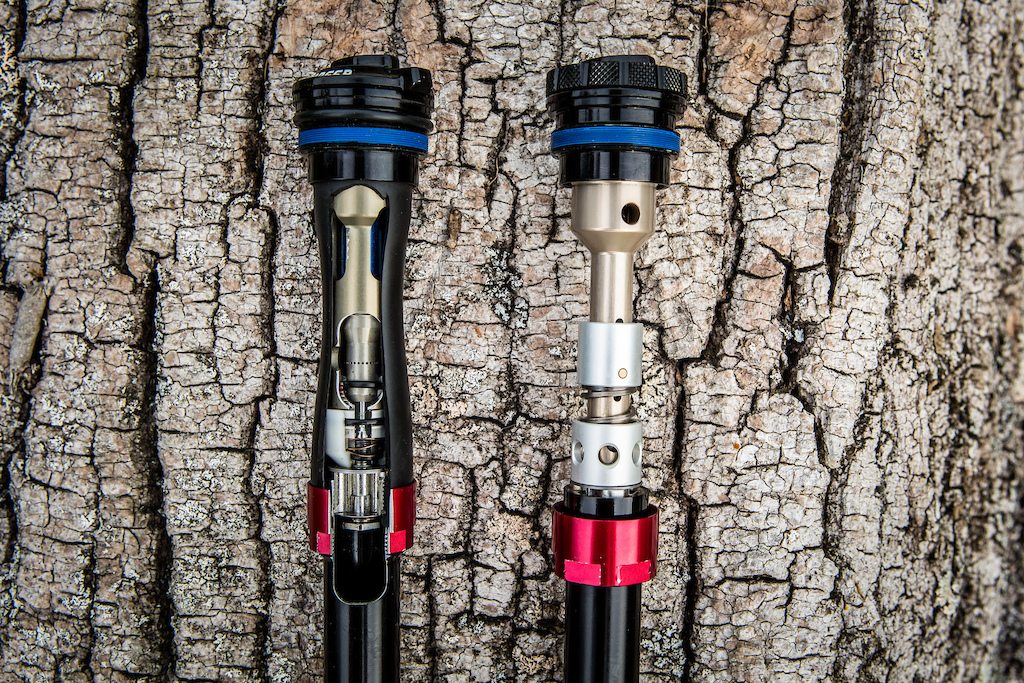
An older Charger 2 RC2 damper (on the right) next to an RCT version from the same era. Here you can see the coil spring that holds closed the high-speed valve according to the position of the high-speed adjuster in the outgoing Charger design.
The problem with this, RockShox say, is that the high-speed adjuster affects the low-speed damping and visa-versa. This is because when you set the high-speed preload to a minimum, oil can start trickling through the high-speed valve even at low shaft speeds, especially if the low-speed adjuster is set to the fully closed position. In our shopping analogy, imagine the low-speed valve that's set to closed as a very narrow door that people have to squeeze through one by one. Next to this is the spring-loaded emergency door, but the spring is loose and allows the door to open wide enough for people to fit through without much effort, so people use both doors even when there's no emergency.
Going back to the damper, this means that opening up the high-speed adjuster will also limit the amount of damping force (the pressure behind the valve) you can get at low shaft speeds (such as when cornering and braking) because the oil has an alternative choice of route. Meanwhile, closing the high-speed adjuster to stop it from moving too much on big hits will also make the fork firmer at low speeds. This is what RockShox refer to as "crosstalk".
With Charger 3, there's still a low-speed valve where the user can adjust the size of an orifice. Oil can flow through this orifice which RockShox call "the easy path," or it can also flow around this orifice through a non-adjustable shim stack - "the hard path". So far, this is essentially the same as a traditional damper without adjustable high-speed damping. However, in Charger 3, before the oil gets to this it first goes through the high-speed valve, which is actually just another fixed-size orifice where a cone adjusts the size of the hole that oil can flow through depending on the position of the HSC adjuster.
When the high-speed adjuster is open and the low-speed is closed, the oil flows relatively freely through the first (high-speed) port, but then is forced around the low-speed port and through the shim stack, which is tuned to give a lot of damping force (restricted oil flow) at low-speeds but still allows plenty of oil to flow (by opening up) at higher speeds. In the opposite case, where the low-speed is open and the high-speed is closed, a much higher proportion of the damping force (oil pressure change) is generated by the high-speed valve.
You can see the overall effect of this in the below graph from RockShox.
Take any graph published by the manufacturer with a pinch of salt, it's not clear to me what RockShox mean by "other dampers". But what this graph trying to get across is that if the Charger 3's low-speed adjuster is fully closed, the high-speed adjuster barely affects the low-speed damping force. Whereas with the mystery "other damper" opening up the HSC dramatically reduces the low-speed damping force. Interestingly, there isn't much difference the other way around - if the LSC is fully open, the two dampers perform broadly the same at either extreme of the HSC range.
Charger 3: What's the Bottom Line?
So, if you boil it right down, Charger 3 makes it possible to have a lot of low-speed damping force while still having the high-speed relatively open. Then if you wanted to firm up the high-speed compression damping too, the low-speed damping behaviour would be relatively unchanged. All this wasn't possible (at least not to the same extent) with previous Charger dampers.
Two Questions with RockShox's Chris Mandell
 How does the range of compression adjustment compare between Charger 2.1 and 3?
How does the range of compression adjustment compare between Charger 2.1 and 3?
- "The amount of damping the Charger 3 produces is tuned to match the Debonair+ airspring."
- "Relative to the Charger 2.1, the 3 makes less HSC and more LSC. It makes more LSC as a result of the Debonair+ spring being softer off the top than the airspring the Charger 2.1 was designed for."
- "The Charger 3.0 has a broader range of LSC and HSC adjustment."
 Why the switch to IFP for Charger 3? Has it got anything to do with trying to reduce crosstalk?
Why the switch to IFP for Charger 3? Has it got anything to do with trying to reduce crosstalk?
"Using an IFP gave us better backpressure in the system (less risk of cavitation). This gave us more freedom in damper design. We used the freedom to increase the range of compression forces we could create and eliminate crosstalk. I’d also note that it allowed us to make the damper considerably easier to service… And quiet."
Buttercups
These are rubber elastomers which sit at the bottom of the spring and damper shafts where they connect to the lower legs. To understand why we might want this, we need to discuss a little theory.
The seals inside an air spring or damper create static friction or "stiction" which has to be overcome before they can start sliding. That means when the wheel hits a bump and the tire starts to compress, the force has to build up to a point where it's sufficient to overcome this stiction before the fork can move at all. Up to that point, the fork is essentially rigid. When you're riding over lots of small bumps (picture a washboard surface), this stiction can significantly numb the response of the fork to the bump forces, making for reduced comfort and traction.
The idea of the Buttercups is to allow a little movement (up to 4 mm according to RockShox) between the lowers and upper tubes without having to also force the spring and damper seals to slide as well. In other words, the stiction that exists in the chassis is spatially offset from the stiction in the internals. In theory, this means the fork could start compressing when the bump force is sufficient to overcome the chassis friction but not sufficient to also overcome the friction in the internals, so it can start moving a little sooner over every bump.
How much of a difference does that make? RockShox claims they reduce high-frequency vibrations by 20%, and that's "proven by science". Obviously, it's the bicycle industry form of science where you don't have to publish any evidence, context, data, or definitions, so take that as you will.
Since they're designed to deal with the smallest-amplitude bumps and attenuate the effect of the (relatively modest) friction in the internals, you might imagine the rubber pucks in the Buttercups are soft and squishy like a bouncy ball. But if you take the fork apart to have a feel, the Buttercups are surprisingly stiff compared to the air spring itself. With the lowers removed and the air spring inflated to 70 psi, I pushed on the end of the air shaft and had to get quite deep into the travel before the Buttercup compressed by more than a millimeter.
With the air shaft removed, I placed the foot end of the air shaft on a digital scale and pushed on the other end to see how much it compressed as the force was applied. You can see the result of this in the above video. Here you can see how much the Buttercup compresses when a downward force is applied to the air shaft. The scale reads up to 5 kg of force. Bear in mind that, according to RockShox, it only takes about 1.6 kg to overcome the static friction in the air spring.
Why is the rubber not softer? RockShox's website may offer a clue: "When we first started out, we had some really soft pucks. We put them on our SIM test machine, which tests for durability, and we started seeing them get chewed up." So perhaps the pucks in the production forks have to compromise suppleness for durability. Of course, this is only a theory.
Since first publishing this article, SRAM told me "the durometer is not related to the pucks getting chewed up in testing. The pucks are there to handle high-frequency inputs to the fork – Inputs that the airspring and Damper are not optimized to manage. The amount of displacement we are trying to deal with is very small but the speed is very fast."
But it's worth underlining that the Buttercups don't do anything to mitigate the effect of the friction between the upper and lower legs, and if the bumps aren't large enough to overcome this force (which is considerable, especially with slack head angles), the Buttercups can't do anything.
It's also worth noting that RockShox aren't the first to do something like this - DT Swiss and EXT have a similar system on the spring side, using a coil spring instead of a rubber bumper.
They can't hurt performance, but it's difficult to say how much benefit they really offer as they are integrated into the new Debonair+ air spring.

The air springs in the 2023 Zeb, Lyrik (pictured) and Pike have changed to aluminum to free up more air volume compared to the outgoing plastic pistons.
Debonair+ Air Spring
The outgoing generation of RockShox air springs was designed such that the piston passes the transfer port (which allows air to freely pass between the positive and negative air chambers) close to topout. This made the forks easier to set up because there was no need to compress the fork into its travel in order to equalize the pressures after making an air pressure adjustment. It also made the fork sag less into its travel because the negative spring wasn't "over-pressurized" relative to the positive chamber at topout. In most air springs, the transfer port is located above the piston at topout, so the chamber pressures equalize a few millimetres into the travel. This means that, at topout, the negative chamber has a higher pressure than the positive one, which makes the fork sink into its travel slightly with a softer spring rate off-the-top (RockShox call this the "touchdown feel", which I think is a good name.)
With the 2023 generation of forks, RockShox have gone back on this; now the transfer port is placed higher up, so the pressures equalize a few millimetres into the travel, creating a softer "touchdown feel" than the previous generation of forks. RockShox say they have increased LSC in the Charger 3 damper to compensate for the softer initial spring rate and the lower ride-height at sag.
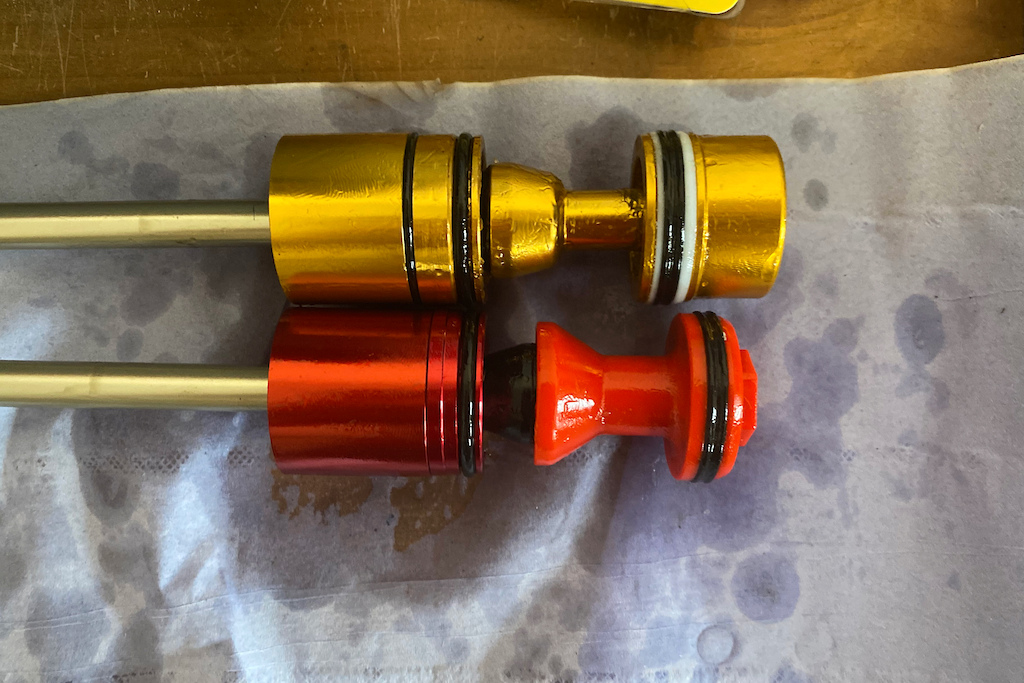
With the 2023 Zeb air spring (top), the seal ring sits slightly lower down in the fork leg compared to the 2020-2022 spring (below), meaning it passes the transfer port deeper into the travel so there's more air pressure in the negative chamber at top out. The gold aluminum piston is bell-shaped and hollow, so there's more negative volume, but less positive volume. Also, note the Teflon backup rings on the new piston.
The transfer port is a small channel cut into the inner wall of the stanchion. With Pike and Lyrik, the upper tubes are all-new so RockShox simply machined the transfer port higher up the stanchion wall. With the Zeb, the upper tubes are the same as last year, so RockShox made a new bell-shaped air piston such that the seal sits lower down in the tube, and so passes the port deeper into the travel. (This also means the Debonair+ air spring is backwards-compatible with all older Zebs). The hollowed-out aluminum piston also leaves more room for an increased negative volume underneath.
This increased negative volume should also make the spring softer before sag but also firmer after sag, relative to the older spring set to the same sag. In other words, more negative volume makes the spring more progressive. At the same time, the increased negative volume leaves less space in the positive chamber, making it even more progressive. You'll probably need fewer volume spacers in the 2023 Zeb than in the previous version.
Another question for RockShox's Chris Mandell
 How do the spring volumes and transfer port locations compare between the 2020-2022 (A1) and 2023 Debonair+ (A2) springs?
How do the spring volumes and transfer port locations compare between the 2020-2022 (A1) and 2023 Debonair+ (A2) springs?
"At topout the transfer port lives above the air piston. This allowed us to have a soft ‘touchdown’ feel and supple small bump performance (note above where the damper is tuned to match this – we don’t want the fork diving into the travel). We have also tuned the shape of the transfer port to work with the air piston design so that it ‘gulps’ the exact right amount of air every time (the Teflon back up rings play a role here as well). Another benefit of this is that the fork is usually travelling at speed when it goes over the transfer port, which means the rider never experiences a ‘dead’ feeling portion of the travel."
Author Info:
Must Read This Week
Sign Up for the Pinkbike Newsletter - All the Biggest, Most Interesting Stories in your Inbox
PB Newsletter Signup
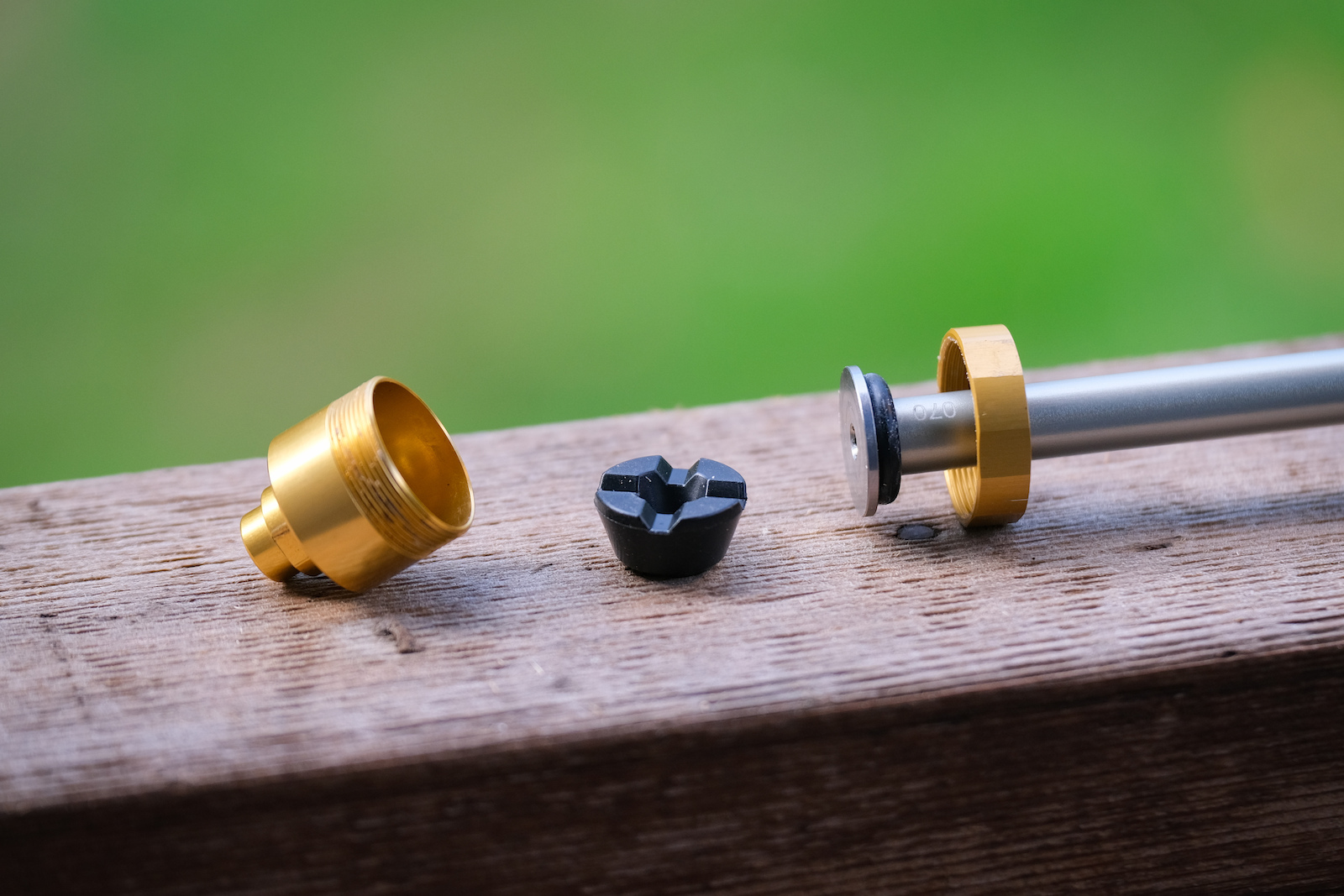


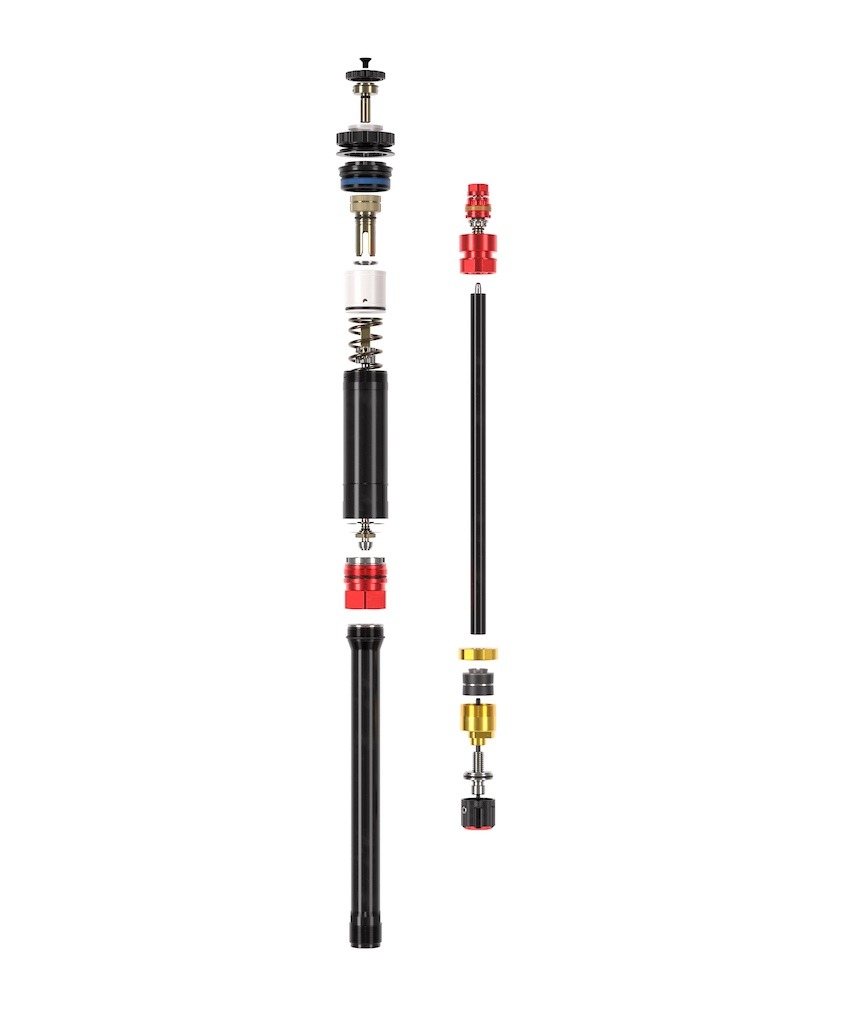

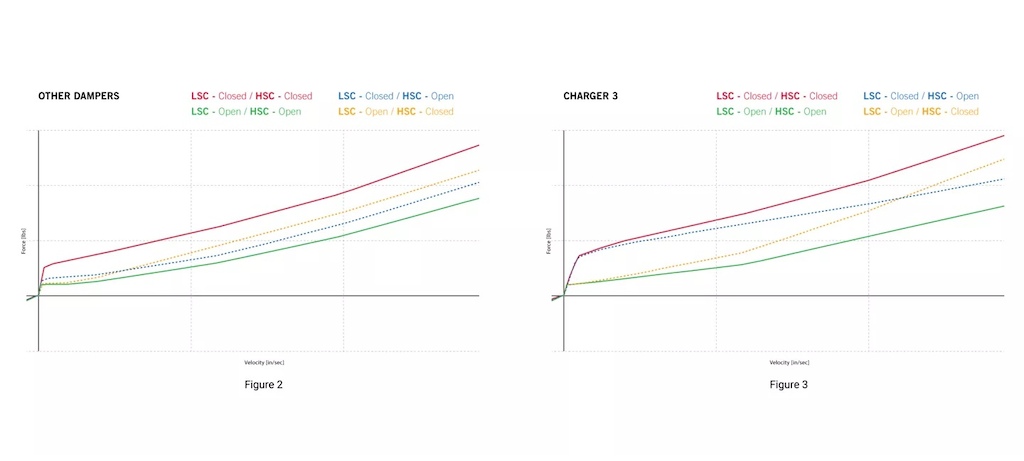
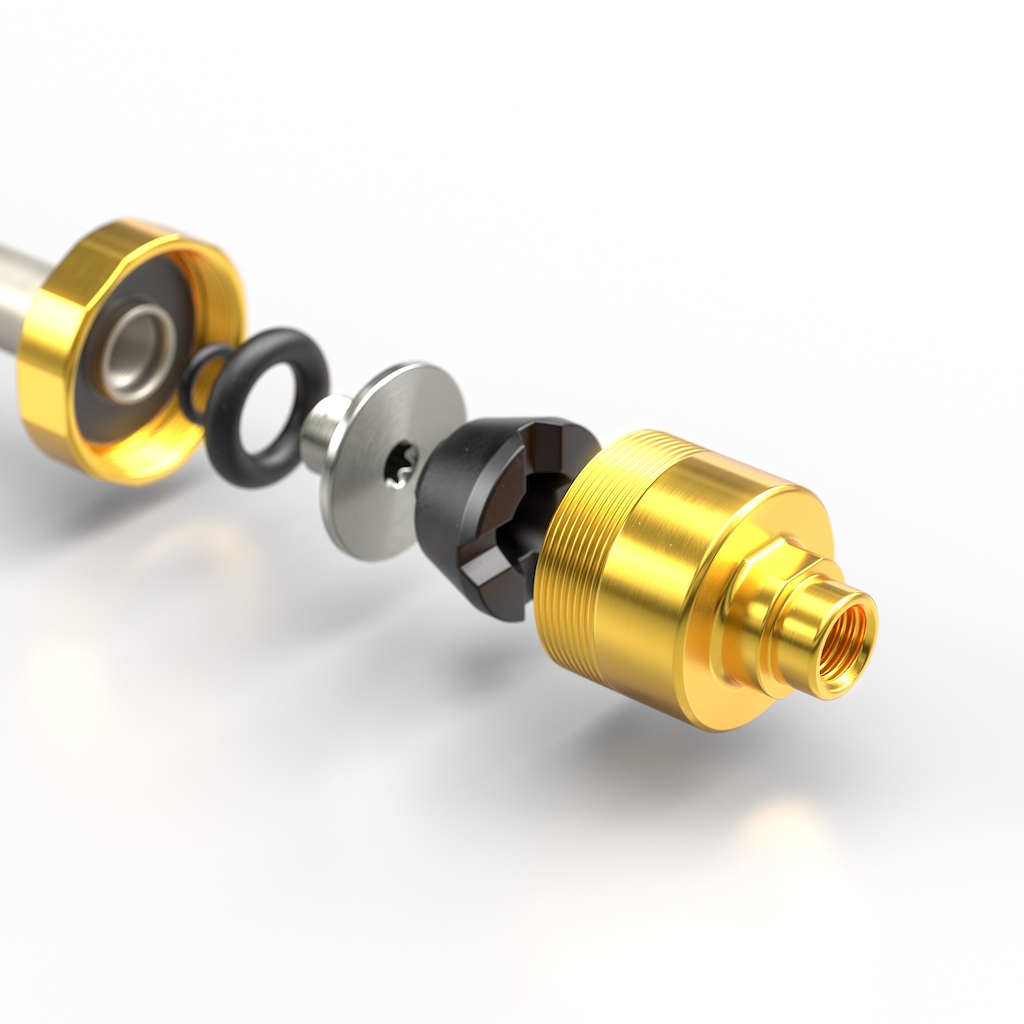


Thanks for an interesting and detailed article anyway, I suspect I'll be coming back to it.
2023 RS stuff with 2.1 damper is such a bargain right now
My friend is riding the new damper and old spring and says it's still giving a lot more support than the 2022 fork.
It'd be interesting (if a bit geeky) to also ride the old damper/new spring and compare the 3 or 4 set-ups back-to-back.
How about that for a feature idea @seb-stott ?
Unfortunately rebuilding them out the box is the only way to make sure it's functioning as it should.
I did actually have to disassemble my 2023 Zeb after an oil leak in transit.
More riding required TBH.
My unsubstantiated theory is that they implemented them to prevent shops from over torquing the damper and spring shafts then cracking them, since doing so with the cups in place would just compress the elastomer a little further and it isolates the shaft from the threads. I could be mistaken, but I know this has been an issue with some bike shops that don't deal with suspension properly and that's the only thing I can see them being useful for.
*If they even work since they have seem to have more internal resistance to movement than the air spring's actual stiction. Then it hurts with respect to being another wear part that needs maintenance.
Am I missing something? I could very well be as I am no engineer.
They are marketing it as a vibration damping solution, however things are often designed with one purpose then marketed as another. These could have multiple possible benefits: reduced likelihood of someone cracking a damper shaft by overtorquing it (this happens with some frequency as per my understanding), possibly make the fork feel less sticky as seals/oil wears over time (since most people don't maintain their suspension properly), and/or vibration damping, although I find the latter a bit sus. It's also possible the vibration damping is something that works well in a lab, but in practice and with production forks that aren't in perfect tolerances, not so much. You can have someone burnish the bushings (if they are sized wrong) and ensure proper oil in the lowers to help some, though.
Either way, for me the new Lyrik felt OK with them in it, I didn't get along with the Zeb though.
And try to decipher the three code numbers
For the same part.
Its Sram the company that has 30+ bleed blocks in their catalogue.
Really
The one thing I have learned in the last 20 years is that everything is compromise and I would rather compromise weight over performance or comfort when it comes to coil v air. I just feel more comfortable on coil front and rear, I dont care about changing a spring if I put weight on or somehow lose weight, I dont care that I cant get springs in 1lb increments, I just care that my coils small bump is outstanding, it supports in the middle and doesnt bottom out or blow though the travel.
That said, I’m excited to try the new version and the buttercups and see how they feel.
SRAM tries to sell a new complete cartridge
I hope I'm not the only pedant annoyed by this trend (which I'm seeing all over the place and not just in biking).
I also didn't break it down like I did my Lyrik and ensure proper oil volume, no excess busing friction, oil seals, clean excess grease of the air spring piston, etc. It might have been improved by those things but I got so annoyed it felt like shit after paying >$1k for it and having to immediately do a bunch of work to it, I just got rid of it and moved on. This may also account for the variations in experiences you see, I just think it's bullshit you spend so much and immediately have to do a bunch of work to it to make it feel right.
I Bought a bike with “simpler” suspension (SDLX select and Zeb R) on purpose to have less chances to make it work worse. Now with time I’m getting ready for more tunability, though my wallet is not so
Thank you for an interesting read.
That's not the right way to think about it. Closing the adjuster (adding damping) adds _control_ to the movement (by applying an opposite force proportional to the shaft speed). It's not just trying to _stop_ the movement.
You need to call out this bullshit louder. Telling us something is better, and then telling the next new thing is also better,except it's the same as original which means the first "better" was a f*cking lie. This is change for the sake of change, it's completely anti-customer.
Because you realized the explanation of "it enables a mode that decreases small bump compliance _and_ bottom out resistance" is something that not many people want?
The current paragraph still kinda has it backwards. It's less that Charger 3 lets you add high-speed without altering low-speed (because in "other dampers" you'll already have some high-speed* in order to have a lot of low-speed) and more that it lets you _reduce_ high-speed without losing low-speed. It's removing one extreme of adjustment that just isn't really super common.
*(which is fine in practice because you probably _do_ want some control of high-speed movements)
THANK YOU
Good for him that he can run a Ikon for enduro trails but doesn't work for other/most people.
Whether the small loss of unsprung mass in certain forks can be felt by a typical rider, and whether it weighs up against the disadvantages that came with those design choices is a different matter of course....